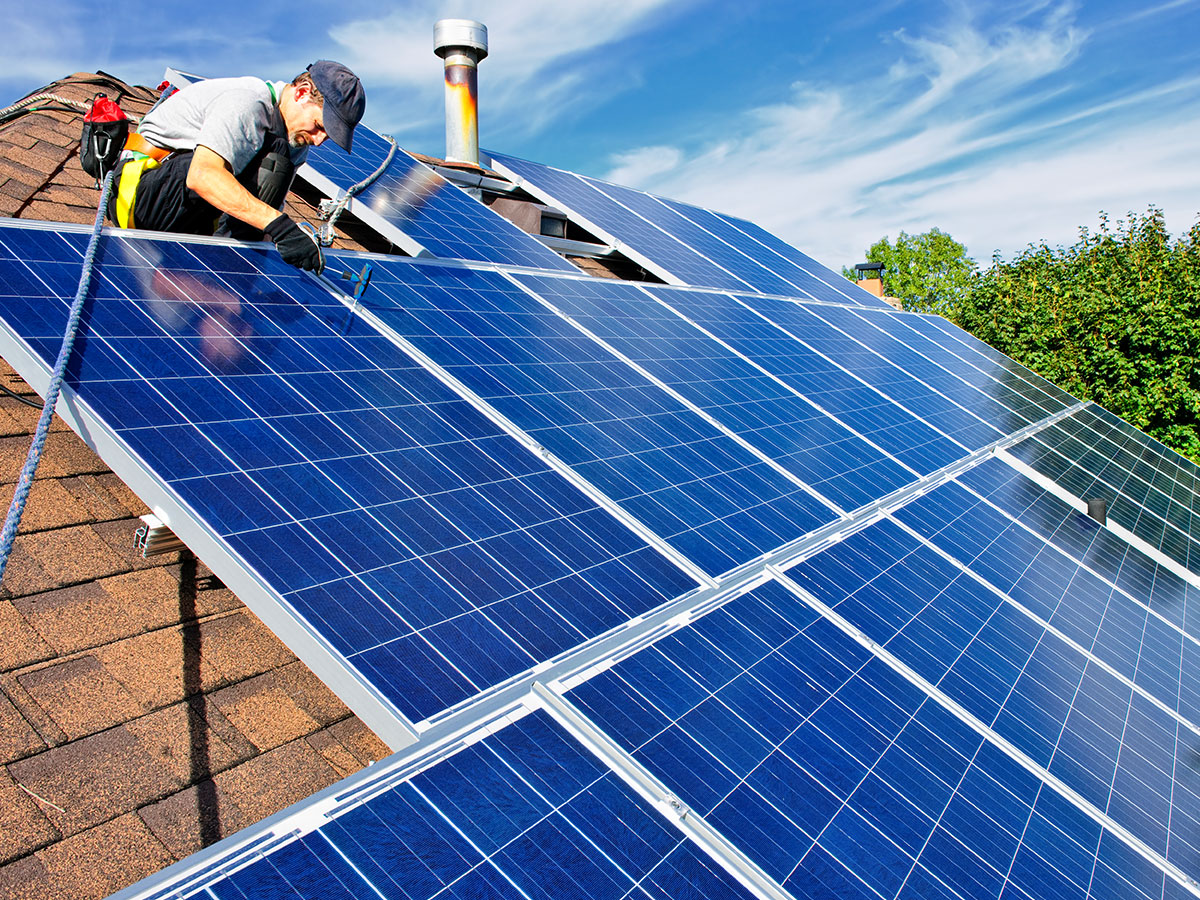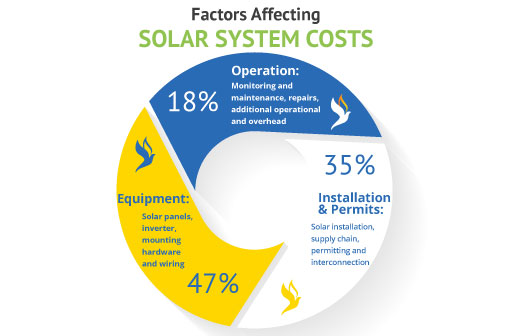
Cost of Solar

Solar Costs
Solar energy costs have dropped significantly over the past years.
A decade ago, the average 6-kilowatt-hour residential solar energy system would cost more than $50,000. Today, solar is much more affordable because of advancements in technology.
Discover the cost of solar for your home.
Residential Solar
Solar panels are rapidly spreading over American rooftops. As a result, residential solar energy costs are at their lowest in over 30 years. Not only more affordable than ever, but today’s residential solar panels also feature technological advances to maximize power production.
Average Solar System Cost
The cost to install a solar photovoltaic (PV) system includes hardware costs and “soft” costs. Hardware includes not only the solar panels and inverter but also the mounting hardware and wiring. Soft costs include labor, permits, and such.

Take control of your electric future with GTFPower. Don’t be at the mercy of the next rate hike by your utility company. Instead, join the millions of American households that have started using solar energy. Whenever you’re ready, GTFPower Solar Advisors are prepared to assist and provide you with a free quote. See how much you can save with Solar.
What Factors Affect Solar System Costs?
A single solar panel can cost between $200 to $250. The cost depends on the quality, makeup (monocrystalline or polycrystalline cells), power output, and efficiency rating.
The size of a system is determined by how much energy you use, your roof’s sunlight exposure, and panel efficiency. The full cost of a solar system will depend on the number of panels and the total wattage output.
The amount you save will depend on several factors, including:
- Your roof and region’s sunlight exposure.
- Equipment costs (including panels, inverter, and battery).
- How much the electric company charges in your area.
- Total energy usage.
- Any tax and local rebates/incentives.
The average Return on Investment (ROI) for a residential solar system will be six to nine years.
A Closer Look at What Determines the Cost of a Solar Energy System
Maintenance Costs
If you lease your system, the solar company is typically responsible for repairs and regular maintenance. However, if you own the system, unless you have an annual inspection and maintenance agreement, you are responsible for regular maintenance. Cleaning and inspecting the system are not usually included in the warranty.
The maintenance of solar energy panels ranges from routine cleaning to repairs. On average, a typical cleaning runs about $100 - $350. The actual charge is based on roof slant, home height, and system size.
If there is damage to your system, repairs will include replacement equipment and labor. Labor is typically priced at $100 per hour. The four most common types of damage to a home solar system and the typical repair costs are:
| Category | Cost Breakdown |
|---|---|
| Broken glass panel | $20 – $350, plus labor |
| Cracked panel | $100 – $400+ |
| Loose connection | $100+ |
| Replacement inverter | $100 – $2,500 |
Like cleaning costs, repair costs are affected by roof steepness, system type, and system size. In some cases, if a solar panel has extensive damage, it may be more economical to replace than repair.
When you own your system, you are responsible for the cost of maintenance and repairs; however, your warranty should cover certain system failures.
With a GTFPower solar lease, you save maintenance and repair costs. You only pay for the power, and we take care of the rest. In addition, our comprehensive service package features the GTFPower warranty, which includes best-in-class monitoring, free equipment replacement, and system repairs, including parts, labor, and routine maintenance.
If buying a solar system outright, you can also purchase the GTFPower Protection Plus, our fully comprehensive service package that features the GTFPower warranty. Although you own the system, we’ll give you the same comprehensive support that comes with our GTFPower warranty.
Solar Panel Manufacturer
The price of solar panels depends on the manufacturer. GTFPower partners with LG, a world leader in solar technology and panels. LG strikes the right balance between quality, efficiency, and affordability. As a result, LG offers some of the best solar panels on the market today.
Your State
Another factor determining your total solar system cost is where you live.
Just because a residential solar system costs more in one state doesn’t mean it’s any less cost-effective than a system in another state. Solar panel cost is low and affordable, and local incentives can make a huge dent in the cost of a solar installation.
Solar Panel Options
The three most common types of solar panels are monocrystalline, polycrystalline, and thin film. Here are the essential features of each:
Monocrystalline
Monocrystalline panels are the most efficient on the market today, which means fewer panels. These solar cells are single-crystal silicon, giving electrons greater freedom to move and create electricity. In addition, these panels are typically black, giving your roof a sleeker aesthetic. Monocrystalline panels also maintain their efficiency for longer and usually come with a 20- to 25-year warranty.
Polycrystalline
Polycrystalline panels are made with many fragments of silicon. Although this type of panel makes them less efficient, it creates less waste in production. They are also more affordable. The polycrystalline panel tends to have a blue tint.
Thin-film
Unlike monocrystalline and polycrystalline panels, thin-film panels are not made of silicon. Instead, they are layered with photovoltaic materials on metal or glass. While the least expensive solar panel option, thin-film is not as efficient and will require more panels than monocrystalline and polycrystalline panels to provide the same amount of energy.
The type of solar panel will factor into the price of the system. However, if you lease the system, you only pay for the power you consume rather than the panels.
Solar Panel Mounts
There are three types of solar panel mounts:
Fix mount ($10–$15 per mount)
Fixed mounts are the least expensive but cannot move to capture more sunlight. Being stationary makes them less efficient than other types of mounts.
Adjustable mount ($50 per mount)
While adjustable mounts are more expensive than fixed mounts, they can be tilted to maximize solar energy production. Adjustable mounts make the most sense for regions with more seasonal climates and less space to maximize energy production. This mount type can also lay the panels flat during a storm to help avoid wind damage.
Tracking-mount ($500–$3,000 per mount)
The most expensive mounts; however, track-mountings can add as much as 45% more energy production. Tracking-mount follows the sun’s arc for maximum energy production and might be worth considering based on your location. Track mounting is more difficult to install and more costly to maintain.
Rebates and Incentives Reduce Solar Costs
Local incentives, tax credits, and rebates help reduce the cost of a solar energy system. The availability of these types of incentives depends on where you live. In general, utilities, cities, and states offer special solar incentives for those living within their service areas. These rebates and incentives can help shorten your solar panel payback period and maximize your savings.
Federal Solar Tax Credits
Federal solar tax credits are designed to reduce the purchase and installation costs of a new home solar system. Home solar systems installed by December 31, 2032, provide a dollar-for-dollar reduction against your federal income tax equal to 30% of the final cost of a solar energy system. Beginning in 2033, the tax credit will be 26%. In 2034, the tax credit will be 22%. The tax credit expires starting in 2035 unless Congress renews it.
GTFPower can help you apply for the Federal Solar Tax Credit. Learn more about federal solar incentives.
Local Solar Incentives
In addition to the federal solar tax credit, some states offer additional tax credits for installing a home solar system. These programs enable you to deduct a portion of the system’s cost from your state tax bill, similar to the federal solar tax credit. In addition, some states also offer solar rebates.
Why GTFPower
Every home is different and every family’s electricity needs are unique. GTFPower experts are here to help you. We design, install, finance, insure, monitor, and maintain home solar systems. As a preeminent residential solar, battery storage, and energy services company, we provide industry-leading service, products, and financing options to meet every family’s needs.
